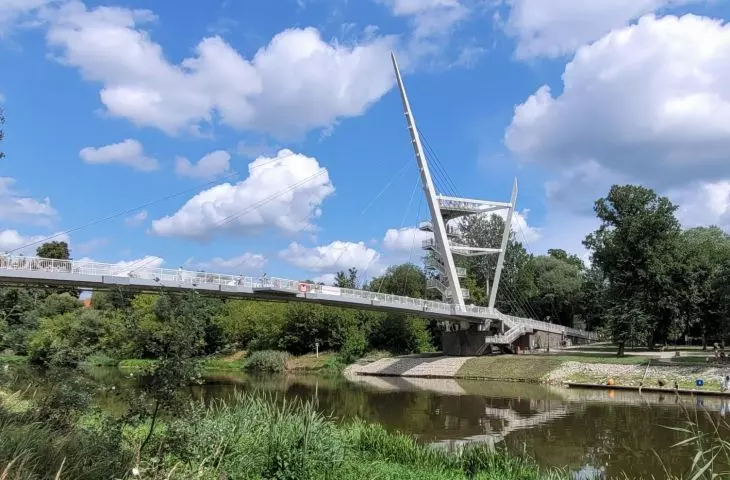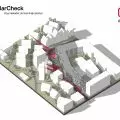A new bridge over the Warta River has been built fifteen kilometers north of downtown Poznań. This much-needed shortcut across the river is, for now, primarily a successful visual and tourist attraction. It will only gain its full functionality after the construction of good bicycle paths leading to it.
The town of Owińska near Poznań (Czerwonak municipality) has so far been famous for the exceptional beauty of its post-Cistercian monastery complex, which for many decades has housed a school and an educational institution for blind children. Europe's first Spatial Orientation Park for the institution's alumni has also been there for a decade. There are also the palace and buildings of a 19th-century psychiatric hospital awaiting extensive restoration. These attractions have now been joined by another: a pedestrian and bicycle bridge with an observation tower. It connects the village, located on the right bank of the Warta River, with a forest on the outskirts of Poznan and the Suchy Las municipality, near the former village of Radojewo (since 1987 within the borders of Poznan). It was built on the site of a former ferry crossing that operated from the Middle Ages until the 1940s.
Pedestrian and bicycle bridge in Owińska near Poznań, designed by Atelier Paweł Byrski—view from the tower over the post-Cistercian complex in Owińskach.
photo: Jakub Głaz
green with greenery
The new bridge has been in operation for two weeks; on Friday it was officially opened. It is crowded with local residents and Poznan citizens, which is not surprising, since it was built in a very picturesque place and connects attractive green areas on both sides of the Warta River. On the Poznan shore, these include wooded riverside areas and—further west—the Morasko Nature Reserve. On the southeastern side of Owińsk, on the other hand, stretches the Zielonka Forest.
Pedestrian and bicycle bridge in Owińska near Poznań, designed by Atelier Paweł Byrski—right bank of Warta River in Owińska, view from the south
photo: Jakub Głaz
The light-line suspended footbridge together with the observation tower reaching almost 25 meters is a very expressive form—a strong accent against the surrounding greenery. The tendons of the bridge are suspended from a pylon leaning strongly toward the river. Its compositional counterbalance is provided by two lower and slimmer pylons directed diagonally towards the shore. Between them has been inserted the structure of the observation tower with a very sculptural character. The tower's two expressive triangular platforms are located at the very top and at a height of 10 meters, respectively.
Pedestrian and bicycle bridge in Owińska near Poznań, designed by Atelier Paweł Byrski
photo: Jakub Głaz
The project, designed by Atelier Paweł By rski (based in Choszcza), was implemented from 2021. The footbridge was built by the Sopot-based company MOST as a joint venture between the Czerwonak municipality, the City of Poznań, the Poznań District and the Suchy Las municipality. Cost: PLN 27 million (with EU funding). Official local government websites report that:
The footbridge is about 130 meters long and 3.9 meters wide. Including the entrances on both banks [...] about 200 meters. The longest span over the Warta River has as much as 83 meters. Meanwhile, all of the newly created bicycle infrastructure is 10 m above the water level.
Pedestrian and bicycle bridge in Owińska near Poznań, designed by Atelier Paweł Byrski—view towards Owińska.
photo: Jakub Głaz
The entire structure consists of three spans. A steel superstructure carries the reinforced concrete slabs of the pedestrian way, and on the Radojevo side, part of the entrance ramp rests solely on the ground. Within the middle span there are also protruding „bays” with benches for resting and observing the area.
Pedestrian and bicycle footbridge in Owińska near Poznań, designed by Atelier Paweł Byrski; in the foreground—a rest area, view towards Owińska
photo: Jakub Głaz
two arches into a bridge
The crossing is also made more dynamic by routing the curved section towards Radojewo and slightly curving the entire pedestrian way. These soft lines correspond well with the large accumulation of triangular and diagonal shapes. The successful composition of the whole has the right proportions and does not allow the viewer to get bored, offering different views from almost every side.
Pedestrian and bicycle bridge in Owińska near Poznań, designed by Atelier Paweł Byrski—view from Radojewo
photo: Jakub Głaz
Some passages even seem a bit too diverse and overloaded. This „overkill” applies primarily to the tower, whose design could have been simplified somewhat. It also raises the question of whether this interesting, albeit very strong spatial gesture is justified in a natural setting within the river's ecological corridor.
Pedestrian and bicycle footbridge in Owińskach near Poznań, design: Atelier Paweł Byrski—view from the upper platform
photo: Jakub Głaz
How does the footbridge perform functionally? We checked it on Sunday, when it attracted quite a few pedestrians and cyclists. The four-meter width of the crossing seems sufficient (resting „bays” work well), but the problem is the collision of pedestrian and bicycle traffic. Their separation is mandated only on a short section at the entrance from Owińsk (there are also stairs leading directly from the bank, on the side of a small river marina). The problem of such collisions is quite typical for similar constructions serving not only communication, but also observation of the area. Designers do not want to designate either side of the bridge for cyclists only (this is the case, for example, with a footbridge under construction in Warsaw).
Pedestrian and bicycle bridge in Owińska near Poznań, designed by Atelier Paweł Byrski; entrance from Owińska, on this side there is traffic separation
Photo: Jakub Głaz
Next to the new bridge, it is also necessary to add at least a dozen bicycle racks (currently there are two on each side!) and more benches and tables.
Pedestrian and bicycle bridge in Owińska near Poznań, designed by Atelier Paweł Byrski; picnic area on the right bank in Owińskach.
photo: Jakub Głaz
Finally, not very pleasant are the rather strong vibrations that the observation tower can get into. It is known that for similar structures such a phenomenon is acceptable. Let's hope that in Owińskach it is within the norm (it took a several-year-old girl less than a minute to strongly rock the viewing platform).
Pedestrian and bicycle bridge in Owińskach near Poznań, designed by Atelier Paweł Byrski—view towards Radojewo from the highest level of the tower
photo: Jakub Głaz
bridge without roads
Finally, it's time to evaluate the new bridge in a broader context. It is certainly an amenity for occasional bicycle and pedestrian enthusiasts. Worse for users who would like to use the new shortcut across the river during their daily commute. After all, there is still no decent bicycle infrastructure nearby, leading towards Poznań and Sucha Las. Yes, there are sections of roads for cyclists on the left bank, but they do not form one decent route. The forest trails are also inconsistent, with sandy or gritty surfaces and poorly marked.
Pedestrian and bicycle footbridge in Owińska near Poznań, designed by Atelier Paweł Byrski—entrance to the footbridge from the forest from the side of Radojewo
photo: Jakub Głaz
In an article published by transport-publiczny.pl, activist Karol Raniszewski of the Bicycle Poznań association comments on the problem:
The premise of the investment was to connect Poznań and the Czerwonak municipality as part of Integrated Territorial Investments. So in order to meet this goal and ensure the economic efficiency of the project on the Poznan side, a [...] comfortable bicycle path with a bituminous surface must be built. At the moment, in practice, there is no bicycle access to the footbridge from Poznań—the trail leads along forested, sandy ducts, passable by mountain bike for a few months a year at most.
Pedestrian and bicycle bridge in Owińska near Poznań, designed by Atelier Paweł Byrski—the Warta River viewed from the viewing tower from the north
photo: Jakub Głaz
Raniszewski also rightly complains about the lack of coordination in the creation of bicycle infrastructure at the provincial level. So when can the situation in the vicinity of the footbridge in Owińskach be expected to improve? Representatives of Poznan's magistrate's office have announced that a route of about 10 kilometers from Poznan's Lech Bridge should be built in the coming years—financed by funds from the new EU perspective until 2027. This is because so far the City has focused on expanding the so-called Wartostrada on the central section of the Warta River in the city. In a few months, construction of the downtown Berdych Bridge for cyclists and pedestrians will also begin.































































































